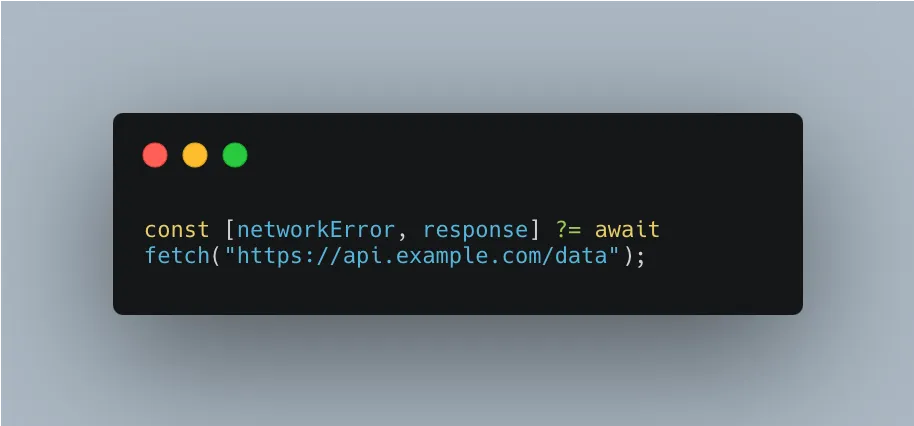Introduction
Error handling in JavaScript has always been a pain point for developers. While try/catch blocks get the job done, they often lead to cluttered, hard-to-read code—especially when dealing with asynchronous operations. But what if there was a cleaner, more elegant way to handle errors?
Enter the optional chaining operator (?.) and its powerful companion, the ?= operator—a game-changer in modern JavaScript error handling.
In this article, we’ll explore:
- Why traditional
try/catchblocks can be problematic - How the new
?=operator simplifies error handling - Real-world examples comparing old vs. new approaches
- Why this feature will make your code cleaner and more efficient
Let’s dive in!
Problem with Traditional try/catch Blocks
For years, try/catch has been the go-to method for handling errors in JavaScript. But while it works, it comes with some major downsides:
1. Repetitive & Bloated Code
Every time you need to handle a potential error, you must wrap it in a try/catch block. This leads to repetitive, nested structures that make code harder to follow.
2. Breaks Code Flow
Error handling logic often overshadows the main functionality, making the code less readable.
3. Inefficient for Asynchronous Operations
Async functions (like API calls or file operations) require even more nested try/catch blocks, increasing complexity.
Here’s what a typical try/catch block looks like:
try {
const response = await fetch('<https://api.example.com/data>');
const data = await response.json();
console.log(data.user.name); // Risky if `user` is missing!
} catch (error) {
console.error("Something went wrong:", error);
}This works, but what if we could make it cleaner and more concise? Additionally, what if there was a way to handle errors more efficiently, without all this boilerplate?
Solution: JavaScript’s New ?= Operator
The ?= operator (part of ECMAScript’s latest features) provides a cleaner, more concise way to handle errors. Instead of throwing exceptions, it returns a tuple:
[error, result] = someOperation() ?= fallbackValue;- If
someOperation()succeeds →[null, result] - If it fails →
[error, fallbackValue]
This eliminates the need for bulky try/catch blocks while keeping error handling explicit and predictable.
Example: Fetching API Data
Old Way (with try/catch)
async function fetchUserData(userId) {
try {
const response = await fetch(`/api/users/${userId}`);
const data = await response.json();
return data;
} catch (error) {
console.error("Fetch failed:", error);
return null;
}
}New Way (with ?=)
async function fetchUserData(userId) {
const [error, data] = await fetch(`/api/users/${userId}`).json() ?= [null, null];
if (error) console.error("Fetch failed:", error);
return data;
}Notice the difference? The second version is shorter, cleaner, and more intuitive.
Why the ?= Operator is a Game-Changer
1. Cleaner, More Readable Code
- No more deeply nested
try/catchblocks. - Errors are handled inline, keeping logic linear and easy to follow.
2. Centralized Error Handling
- Errors are returned as values, making them easier to track and manage.
- No more scattering
catchblocks throughout your code.
3. Better Performance
- Fewer nested blocks mean less overhead for the JavaScript engine.
- Optimized for async workflows (like API calls and Promises).
4. Perfect for Modern JavaScript
- Works seamlessly with
async/await. - Integrates well with frameworks like React, Next.js, and Node.js.
When Should You Use ?= Instead of try/catch?
| Scenario | try/catch | ?= Operator |
|---|---|---|
| Simple synchronous checks | ✅ Good | ⭐ Better |
| Async operations (Promises, fetch) | ❌ Cumbersome | ⭐ Perfect |
| Deeply nested error handling | ❌ Hard to maintain | ⭐ Clean & Simple |
| Fallback values | Requires extra logic | ⭐ Built-in |
Conclusion: Embrace the Future of Error Handling
JavaScript is evolving, and the ?= operator is proof that we’re moving toward cleaner, more efficient ways to write code.
No more:
❌ Bloated try/catch blocks
❌ Deeply nested error handling – Making code harder to read and debug.
❌ Scattered error checks – Forcing you to hunt for validation logic.
Instead, we get:
✔Concise syntax that saves time
✔ Better readability for easier debugging
✔ More maintainable code for long-term projects
Ready to simplify your error handling? Start experimenting with ?= in your next project and see the difference for yourself!
Ready to Try It?
If you’re using the latest versions of Node.js, Deno, or modern browsers, you can start using ?= today!
What do you think? Will you switch from try/catch to the ?= operator? Let me know in the comments!

